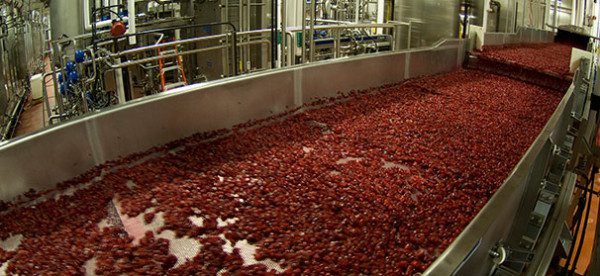

Aug 1, 2013Cranberry growers look for ways to trim surplus
Cranberry growers in the United States are battling steep surpluses and declining prices, along with increased competition from Canadian and overseas producers.
To offset the imbalances, the U.S. Cranberry Marketing Committee, based in Wareham, Mass., is pursuing an “aggressive decision to get very active to create more demand,” according to Scott Soares, the committee’s executive director.
The United States produced 402,300 tons of cranberries last year, an increase from 385,700 the year previous. Before an expansion that involved replanting and larger bogs to meet anticipated demand that largely did not materialize, the industry produced 327,700 tons in 2007.
In Wisconsin, which produces the majority of the world’s cranberry crop, industry leaders said a recent announcement by USDA that it plans to purchase cranberry juice concentrate for domestic food programs would be welcomed. The purchase will be made through USDA’s Section 32 program, which authorizes the Secretary of Agriculture to purchase surplus foods from U.S. farmers. Purchases are funded from tariffs (import duties collected from customs receipts).
“The USDA’s purchase will assist cranberry growers nationwide, as they face an oversupply of the crop,” said Tom Lochner, executive director of the Wisconsin State Cranberry Growers Association (WSCGAS). “Growers had an exceptionally successful harvest this past year and faced greater concentration from Canadian cranberry growers, resulting in the oversupply. We are working hard on our marketing efforts to increase the demand for cranberries, but we are very thankful that in the short term our fruit can be incorporated into the government’s nutrition assistance programs.”
While stressing that the Cape Cod Cranberry Growers’ Association (CCCGA) defers to the U.S. Cranberry Marketing Committee and cranberry handlers regarding supply and demand issues, its spokeswoman acknowledged that Massachusetts growers have been impacted by the “price disparity due to oversupply and demand balances.
“This industry as a whole has ramped up technology, newer cranberry vine planting and improved grower practices, which has equated to increased production,” said Dawn Gates-Allen, CCCGA communications manager. “We as an industry have the growing ability mastered, barring any problems that Mother Nature negatively creates for our growing conditions. We are working toward better distribution and marketing efforts to help reduce inventories, and we hope that growers can weather the price-per-barrel storm.”
Rather than recommend that USDA implement a marketing order to manage domestic cranberry production levels, Soares said the marketing committee has made a conscious effort to “become much more aggressive to create more demand.”
He said the group’s international market development subcommittee is attempting to make inroads in China and Russia, and is conducting investigative work in Brazil and India.
“We’ve verified these are places we should be looking to increase demand,” he said.
Domestically, the committee is conversing with USDA to generate more federal purchases. USDA’s recent $5 million purchase, while taking 110,00 to 130,000 barrels off the market, falls short of the 500,000 barrels the industry had targeted for the buy.
“We’re also working more with schools and school nutrition programs for them to recognize and adopt cranberry products – and not just cranberry sauce,” Soares said.
Cranberry operations in Wisconsin, in particular, have expanded acreage and production in recent years based on demands from Ocean Spray and other processors, which anticipated strong growth in overseas sales of juice and sweetened, dried cranberries. But overseas increases amounted to just 2 percent to 3 percent, while demand in the U.S. market also was bottoming out due to the recession.
U.S. farmers were left with a huge excess of cranberries this fall, after an unanticipated rise in production in Canada. Farmers who don’t belong to the Ocean Spray cooperative have received $22 to $28 per 100 pounds for a fall crop that cost them $25 to $30 per 100 pounds to produce. Some analysts predict those prices could fall to $15 to $18 per 100 pounds if market conditions don’t improve for the 2013 crop.
“Clearly the demand has been static internationally and domestically for the last couple of years,” Soares said. “At the same time, there has been increased production – not as much domestically but internationally, and in Canada in particular.”
Soares said the 2.3 percent increase in domestic production in 2012 “was not significant growth of great concern.” It came primarily from a 280,000-barrel increase in Wisconsin, while there was an approximately 200,000-barrel reduction in Massachusetts.
“Growth in the 2011-year domestic crop was minimal when compared to a 55 percent increase in British Columbia and Quebec,” he said. “Production increases in Canada went from 1.5 million barrels in total to 3.3 million total. That’s quite an increase, and Canadian growers and producers recognized that.
“Some of the good news is we’re working very actively with Canadian producers to do some analysis, and the development of an order similar to our cranberry marketing order, for Quebec in particular,” Soares said. “We’re working with the B.C. folks to have a commission similar to what the U.S. Marketing Committee does. There’s nothing in place at this point, but we’re working with them and their consultant to help create a mechanism to manage volumes while working to increase demand internationally.”
Soares said the structure of such an arrangement remains unclear.
“Beyond a strong willingness for cooperation on both sides of the border, it is undetermined at this point how we will work together in the future,” he said.
Soares said the industry has been on an accelerated production pace for the past decade, citing 2002 production of 4.8 million barrels and 2012 domestic output of 8 million barrels.
“That there has been generally increased crop from year to year is a testament to the growers’ ability to grow cranberries very well,” Soares said. “We’re not a big industry compared to other crops. Some see it as a great opportunity, and I fall in that category.”














